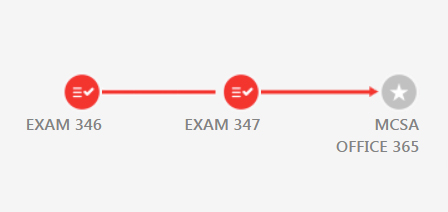Course Outline
Module 1: Planning and provisioning Office 365
This module reviews the features of Office 365 and identifies recent improvements to the service. Additionally it describes how to configure an Office 365 tenant and plan for a pilot deployment.
Lessons
Overview of Office 365
Provisioning an Office 365 tenant
Planning a pilot deployment
Lab : Provisioning Office 365
Configuring an Office 365 tenant
Configuring a custom domain
Exploring the Office 365 administrator interfaces
After completing this module, students will be able to:
Describe Office 365.
Provision an Office 365 tenant.
Plan a pilot deployment.
Module 2: Managing Office 365 users and groups
This module describes how to manage Office 365 users, groups, and licenses, and configure administrative access by using the Office 365 console and the Windows PowerShell command-line interface.
Lessons
Managing user accounts and licenses
Managing passwords and authentication
Managing security groups in Office 365
Managing Office 365 users and groups with Windows PowerShell
Configuring administrative access
Lab : Managing Office 365 users and passwords
Managing Office 365 users and licenses by using the Office 365 admin center
Managing Office 365 password policies
Lab : Managing Office 365 groups and administration
Managing Office 365 groups
Managing Office 365 users and groups by using Windows PowerShell
Configuring delegated administrators
After completing this module, students will be able to:
Manage user accounts and licenses.
Manage passwords and authentication.
Manage security groups in Office 365.
Manage Office 365 users and groups with Windows PowerShell.
Configure administrative access.
Module 3: Configuring client connectivity to Microsoft Office 365
This module describes the different types of client software that you can use to connect to Office 365, and the infrastructure requirements that the clients need to meet to connect to Office 365. In addition, this module teaches you how to configure different types of Office 365 clients.
Lessons
Planning for Office 365 clients
Planning connectivity for Office 365 clients
Configuring connectivity for Office 365 clients
Lab : Configuring client connectivity to Office 365
Configuring DNS records for Office 365 clients
Running the Office 365 connectivity analyzer tools
Connecting Office 2016 clients
After completing this module, students will be able to:
Plan for Office 365 clients.
Plan connectivity for Office 365 clients.
Configure connectivity for Office 365 clients.
Module 4: Planning and configuring directory synchronization
This module describes how to plan and configure directory synchronization between Azure AD and on-premises AD DS.
Lessons
Planning and preparing for directory synchronization
Implementing directory synchronization by using Azure AD Connect
Managing Office 365 identities with directory synchronization
Lab : Configuring directory synchronization
Preparing for directory synchronization
Configuring directory synchronization
Managing Active Directory users and groups
After completing this module, students will be able to:
Plan and prepare for directory synchronization.
Implement directory synchronization by using Microsoft Azure Active Directory Connect (Azure AD Connect).
Manage Microsoft Office 365 identities with directory synchronization.
Module 5: Planning and deploying Office 365 ProPlus
This module covers the planning process, how to make Microsoft Office 365 ProPlus directly available to end users, and how to deploy it as a managed package. Finally, this module covers how to set up Office telemetry so that administrators can keep track of how users are interacting with Microsoft Office.
Lessons
Overview of Office 365 ProPlus
Planning and managing user-driven Office 365 ProPlus deployments
Planning and managing centralized deployments of Office 365 ProPlus
Office telemetry and reporting
Lab : Managing Office 365 ProPlus installations
Preparing an Office 365 ProPlus managed installation
Managing user-driven Office 365 ProPlus installations
Managing Centralized Office 365 ProPlus installations
After completing this module, students will be able to:
Describe Office 365 ProPlus.
Plan and manage user-driven Office 365 ProPlus deployments.
Plan and manage centralized deployments for Office 365 ProPlus.
Describe Office telemetry and reporting.
Module 6: Planning and managing Exchange Online recipients and permissions
This module describes Exchange Online and explains how to create and manage recipient objects and how to manage and delegate Exchange security.
Lessons
Overview of Exchange Online
Managing Exchange Online recipients
Planning and configuring Exchange Online permissions
Lab : Managing Exchange Online recipients and permissions
Configuring Exchange Online recipients
Configuring role-based access control
After completing this module, students will be able to:
Plan and prepare for directory synchronization.
Implement directory synchronization by using Microsoft Azure Active Directory Connect (Azure AD Connect).
Manage Microsoft Office 365 identities with directory synchronization.
Module 7: Planning and configuring Exchange Online services
This module describes how to plan and configure Exchange Online services. It also explains how to plan and configure anti-malware and anti-spam settings in Office 365.
Lessons
Planning and configuring email flow in Office 365
Planning and configuring email protection in Office 365
Planning and configuring client access policies
Migrating to Exchange Online
Lab : Configuring message transport in Exchange Online
Configuring message transport settings
Lab : Configuring email protection and client policies
Configuring email protection
Configuring client access policies
After completing this module, students will be able to:
Plan and configure email flow in Office 365.
Plan and configure email protection in Office 365.
Plan and configure client access policies.
Migrate to Exchange Online.
Module 8: Planning and deploying Skype for Business Online
This module describes how to plan and implement the Skype for Business Online deployment. This module also describes how to plan voice integration with Skype for Business Online.
Lessons
Planning and configuring Skype for Business Online service settings
Configuring Skype for Business Online users and client connectivity
Planning voice integration with Skype for Business Online
Lab : Configuring Skype for Business Online
Configuring Skype for Business Online organization settings
Configuring Skype for Business Online user settings
Configuring a Skype Meeting Broadcast
After completing this module, students will be able to:
Plan and configure Skype for Business Online service settings.
Configure Skype for Business Online user and client connectivity.
Plan voice integration with Skype for Business Online.
Module 9: Planning and configuring SharePoint Online
This module describes the administrative features available within SharePoint Online and the most common configuration tasks for any administrator who starts using SharePoint Online. This module also describes the concept of site collections and the different sharing options within SharePoint Online. A brief overview of additional portals, such as the video portal, are also provided.
Lessons
Configuring SharePoint Online services
Planning and configuring SharePoint site collections
Planning and configuring external user sharing
Lab : Configuring SharePoint Online
Configuring SharePoint Online settings
Creating and configuring a SharePoint Online site collections
Configuring and verifying external user sharing Configure
After completing this module, students will be able to:
Configure SharePoint Online services.
Plan and configure SharePoint Online site collections
Plan and configure external user sharing.
Module 10: Planning and configuring a Office 365 collaboration solution
This module describes how to plan and implement a SharePoint collaboration solution, and how to enable Yammer Enterprise services within Office 365 and OneDrive for Business, and Office 365 groups.
Lessons
Planning and managing Yammer Enterprise
Planning and configuring OneDrive for Business
Configuring Office 365 groups and Microsoft Teams
Lab : Planning and configuring an Office 365 collaboration solution
Configuring a Yammer Enterprise
Configuring OneDrive for Business
Configuring Office 365 groups
After completing this module, students will be able to:
Plan and manage Yammer Enterprise.
Plan and configure OneDrive for Business.
Configure Office 365 groups.
Module 11: Planning and configuring rights management and compliance
This module describes the compliance features in Office 365 and explains how to manage them. In addition, it describes how to plan and configure Microsoft Azure Rights Management (Azure RMS). Additionally, it discusses the security features in Office 365.
Lessons
Overview of the compliance features in Office 365
Planning and configuring Azure Rights Mmanagement in Office 365
Managing the compliance features in Office 365
Lab : Configuring Rights Management and compliance
Configuring rights management in Office 365
Configuring compliance features
After completing this module, students will be able to:
Describe the compliance features in Office 365.
Plan and configure Azure RMS in Office 365.
Manage the compliance features in Office 365.
Module 12: Monitoring and troubleshooting Microsoft Office 365
This module describes how to monitor and review Office 365 services, and troubleshoot Office 365 issues.
Lessons
Troubleshooting Office 365
Monitoring Office 365 service health
Lab : Monitoring and troubleshooting Office 365
Monitoring Office 365
Monitoring service health and analyzing reports
After completing this module, students will be able to:
Troubleshoot Microsoft Office 365.
Monitor Office 365 service health.
Module 13: Planning and configuring identity federation
This module describes how to plan and implement identity federation between on-premises AD DS and Azure AD.
Lessons
Understanding identity federation
Planning an AD FS deployment
Deploy AD FS for identity federation with Office 365
Planning and implementing hybrid solutions (Optional)
Lab : Planning and configuring identity federation
Deploying Active Directory Federation Services (AD FS) and Web Application
Configuring federation with Microsoft Office 365
Verifying single sign-on (SSO)
After completing this module, students will be able to:
Describe identity federation.
Plan an AD FS deployment.
Deploy AD FS for identity federation with Office 365.
Plan and implement hybrid solutions.




